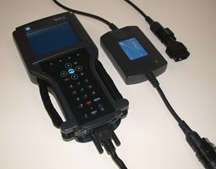Why the GMLAN?
With each change, it’s been possible to increase the speed of data transmission to accommodate an ever-growing number of functions.
Now, starting with 2004, a new GMLAN (Local Area Network) system is being introduced. It will appear first on the Saturn Ion and 2004 Cadillac XLR, and will eventually spread to other vehicle lines (fig. 1).
GMLAN is a reliable, cost effective, flexible, and modular way to handle information sharing between different electronic control units (ECUs) in the vehicle through the means of a family of serial communication buses.
While the domestic automakers were developing UART and Class 2, the European industry was developing a system that operates on the CAN (Controller Area Network) protocol. With the introduction of GMLAN, which also uses the CAN protocol, a common architecture now permits sharing of components from both sides of the ocean.
Some Features of GMLAN
The Class 2 system had only one baud rate -- data was all transmitted at a single speed.
Using the CAN protocol, GMLAN has two different communication links with different data baud rates available -- low speed and high speed.
GMLAN Low Speed Bus
This bus will be typically used for operator controlled functions (for instance, door lock, window motor, etc.) where the system response time requirements are on the order of 100 - 200 msec.
It uses a single wire (also referred to as single wire CAN or SWCAN).
GMLAN High Speed Bus
The high speed bus is typically used for sharing real-time data. Systems with these requirements are primarily powertrain and chassis devices (engine, transmission, brakes). This bus uses two wires, and operates at 500 kbps.
Because there is a common communications protocol on all buses, it’s easier to transfer data from one bus to another.
In the Class 2 system, state of health messages pass from module to module continually. This requires all of the modules to be continually “awake.”
In GMLAN, modules can remain asleep, in a low power state, until asked to perform. Some ECUs may be communicating while others are in low power state. Only those ECUs necessary to participate in a common function are required to be awake. In effect, communication between any collection (or sub-system) of ECUs can be started or stopped independently of any other collection.
Present GMLAN Application
The 2004 Cadillac XLR and Saturn Ion use the GMLAN high speed bus for powertrain applications. Class 2 continues to be used for body and accessory controllers.
CANdi Module and Tech 2
Vehicles equipped with GMLAN require the use of a CANdi module for communication with the Tech 2. Class 2 data will pass through the CANdi module, so it can stay in place regardless of which protocol is being scanned.
The CANdi module (controller area network diagnostic interface) is installed in the data cable between the Tech 2 and the DLC (fig. 2).
The fact that GMLAN can operate at different baud rates enhances the efficiency of vehicle operation and communication. However, the Tech 2 snapshot display frame rate is unchanged.
TIP: Simultaneous to the introduction of the GMLAN is a new diagnostic process called Functional Diagnosis. Watch for more information on this in upcoming issues of TechLink.

figure 1

figure 2